Do you have a question about the Triumph Street Triple R 2014 and is the answer not in the manual?
Diagrams identifying parts for Daytona 675 and 675 R motorcycles.
Identification of controls on the handlebars for Daytona 675 and 675 R.
Identification of controls on the handlebars for Street Triple models.
Identification of additional parts for Street Triple models.
Diagram and explanation of the instrument panel for Street Triple models.
Diagram and explanation of the instrument panel for Daytona 675 models.
Information on ABS circuit mode for closed-circuit use.
Procedure to temporarily disable the ABS system and its implications.
Function and operation of the Tire Pressure Monitoring System.
Guidelines for checking and adjusting tire pressures.
Advice on replacing tires and ensuring TPMS sensor compatibility.
Explanation of various warning lights such as turn signals, high beam, low fuel, neutral, oil pressure, coolant temperature.
What the engine management malfunction light indicates.
Meaning of the ABS warning light and its behavior.
Indication of low tire pressure and its relation to TPMS.
Information on correct fuel grade, refueling procedures, and fuel safety.
Recommended procedures for breaking in new motorcycle components.
Daily safety checks to ensure a safe and reliable ride.
Steps to safely stop the motorcycle's engine.
Procedure for starting the motorcycle's engine.
Instructions on how to move off smoothly and safely.
Techniques for shifting gears up and down.
Operation of the quickshifter for upshifts without clutch use.
Techniques for effective and safe braking using front and rear brakes.
How ABS affects braking performance and safety.
Instructions for parking the motorcycle safely on various surfaces.
Important factors to consider when operating the motorcycle at high speeds.
Risks associated with incorrect loading and how to avoid them.
Instructions for passengers on how to sit and move on the motorcycle.
Overview of scheduled maintenance intervals and procedures.
Procedures for checking, changing, and maintaining engine oil.
Procedures for checking and maintaining the cooling system.
How to check the coolant level in the expansion tank.
Procedure for adjusting the coolant level.
Inspection and adjustment of the throttle control system.
Inspection and adjustment of the clutch lever free play.
Maintenance procedures for the drive chain: lubrication, adjustment, inspection.
Inspection of brake pads for wear and replacement.
Inspection and change of disc brake fluid.
How to inspect and adjust front brake fluid levels.
How to inspect and adjust rear brake fluid levels.
Inspection of steering and wheel bearings.
Inspection of front forks for damage, leaks, and smooth operation.
Inspection of the rear shock absorber for damage or leaks.
Explanation of the tire pressure monitoring system display.
Consequences of tire wear and recommended replacement criteria.
Guidelines for replacing tires and ensuring correct combinations.
Precautions when replacing tires with TPMS sensors.
Safety precautions and warnings related to the motorcycle battery.
Location and identification of fuses in the fuse box.
General information and warnings regarding motorcycle lights.
Steps to prepare the motorcycle for long-term storage.
Procedures for preparing the motorcycle after a period of storage.
Approved tire information, pressures, and recommended sizes.
| Engine Type | Liquid-cooled, 12 valve, DOHC, in-line 3-cylinder |
|---|---|
| Displacement | 675cc |
| Compression Ratio | 12.65:1 |
| Fuel System | Multipoint sequential electronic fuel injection with SAI |
| Final Drive | O-ring chain |
| Clutch | Wet, multi-plate |
| Gearbox | 6-speed |
| Frame | Aluminium beam twin spar |
| Front Tyre | 120/70 ZR 17 |
| Rear Tyre | 180/55 ZR 17 |
| Wheelbase | 1, 410mm |
| Fuel Tank Capacity | 17.4 litres |
| Max Power | 106 PS (78 kW) @ 11, 850 rpm |
| Max Torque | 68 Nm @ 9, 750 rpm |
| Exhaust | Stainless steel 3 into 1 |
| Front Suspension | 41mm upside down forks with adjustable preload, rebound and compression damping |
| Rear Suspension | adjustable rebound damping, and adjustable compression damping |
| Front Brakes | Twin 310mm floating discs, Nissin |
| Rear Brakes | Single 220mm disc |
| Dry Weight | 168kg |
| Bore x Stroke | 74.0mm x 52.3mm |
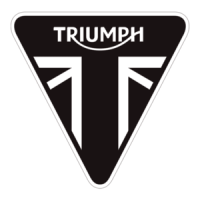

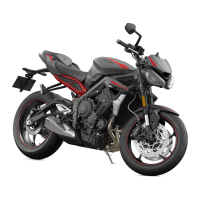
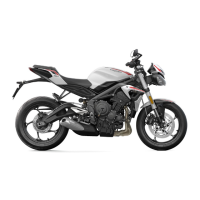

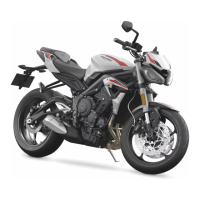

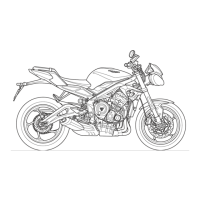


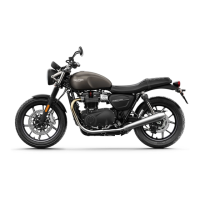

